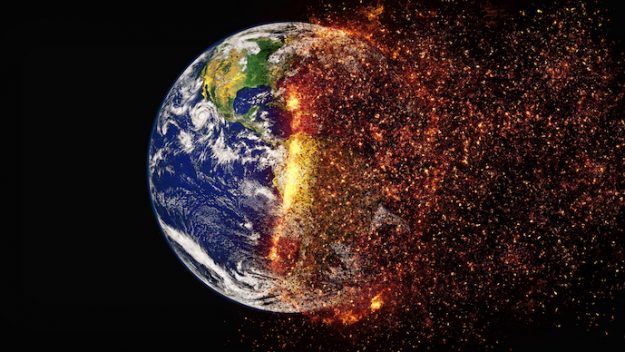
by Janeesha Singh
“Climate change increasingly poses one of the biggest long term threats to investment.”
– Christiana Figueres
Secretary of the UNFCCC
In recent times, there has been an upsurge in the discourse about the looming threat of climate change and the consequences that tread on the heels of such a threat. This new year was brought in alongside the decision of the Bulletin of the Atomic Scientists to move the Doomsday Clock from two-and-a-half minutes to two minutes. The reason cited for such a decision was the failure of President Trump as well as the global community as a whole to deal with the threat of nuclear war as well as climate change. One may argue that President Trump has been an influential figure in pushing the world a step back in dealing with climate change. The Trump Administration has often denied climate change, referring to it as a hoax or a myth. President Trump, often using Twitter as a platform, has gone so far as to deem climate change to be a Chinese plot to destroy America. Recently, he tweeted, “The concept of global warming was created by and for the Chinese in order to make U.S. manufacturing non-competitive.” Despite the fact that in July, 2017 an ice shelf in Antarctica disgorged a block of ice, the size of which was equivalent to that of a small state on the East Coast of America, President Trump continued his trend of climate denial, even tweeting, “Let’s continue to destroy the competitiveness of our factories & manufacturing so we can fight mythical global warming. China is so happy!”
A study revealed that in 2017, 71 percent of independent voters in the US were aware of the fact that scientists believed that the phenomenon of global warming is factual and is materialising at present. However, in light of the wave of climate denial by the current US administration, this percentage has experienced a stark decline, falling from 71 percent to 65 percent within a span of a mere year. Further, a comprehensive analysis of 74 studies within a period of 10 years, i.e., from 2000 to 2010, brought to light that the foremost reason behind a plummet in public concern and discourse about climate change was actions and statements of the Congressional Republicans against climate change, for instance, issuing statements denying the phenomenon of climate change or voting against environment bills in the Parliament. The administration persists on denying the existence of climate change despite concrete proof to the contrary, perhaps due to a false sense of insulation from the cost of climate change.
However, the existence of climate change has manifested itself in concrete evidence all across the globe. The easiest way to observe the increasing temperature is by combing through the thermometer records maintained over the past century and half. All round the world, the Earth’s average temperature has risen more than 1 degree Fahrenheit (0.8 degrees Celsius) over the past century, and about twice that much in parts of the Arctic. The implications of such variation are monumental for it would cause ecosystems to move poleward and sea level to rise.
Is Climate Change a hoax?
- The Greenland and Antarctic ice sheets have decreased in mass. Data from NASA’s Gravity Recovery and Climate Experiment show that Greenland lost 150 to 250 cubic kilometers (36 to 60 cubic miles) of ice per year between 2002 and 2006, while Antarctica lost about 152 cubic kilometers (36 cubic miles) of ice between 2002 and 2005.
- Global sea level rose about 8 inches in the last century. The rate in the last two decades, however, is nearly double that of the last century.
- Since the beginning of the Industrial Revolution, the acidity of surface ocean waters has increased by about 30 percent. This increase is the result of humans emitting more carbon dioxide into the atmosphere and hence, more being absorbed into the oceans. The amount of carbon dioxide absorbed by the upper layer of the oceans is increasing by about 2 billion tons per year.
Developing Countries and Climate Change
While one may realize that climate change will have an impact on the global economy and quality of life around the globe, one may fail to realize that the poor nations may bear the brunt of the economic damage resulting from climate change. Although factors such as technological development, wealth, adaptation may play a role in shaping the impact that climate change has over a nation, the primary factor that shapes such impact is geographical location, i.e., the poor countries will be at the receiving end of climate change due to their location. One of the explanations could be that climate change pushes the countries in tropical regions further away from the optimal temperatures required for climate sensitive economic sectors. Low-income countries will remain on the frontline of human-induced climate change over the next century, experiencing gradual sea-level rises, stronger cyclones, warmer days and nights, more unpredictable rains, and larger and longer heat waves, according to the most thorough assessment of the issue yet. Life in many developing country cities could become practically unbearable, given that urban temperatures are already well above those in surrounding countryside. Oxfam predicted that world hunger would worsen as climate change inevitably hurt crop production and disrupted incomes. They suggested the number of people at risk of hunger might climb by 10% to 20% by 2050, with daily per-capita calorie availability falling across the world.
India and Climate Change
India is one of the fastest developing nations at present. However, the pertinent question of whether India is developing by relying on coal and oil or clean and green energy has a tremendous effect on taming of climate change. India is embarking on one of the fastest rural-to-urban transitions in human history, with 200 million more city dwellers expected by 2030, all using new buildings, roads and cars. However, the population burst that India is experiencing implies that tiny increase in emission by individuals would result in large amounts of carbon-dioxide emissions, placing India at the top of the list of polluters around the globe. However, India is consistently taking steps to curb the problem of climate change. According to a forecast by the Indian government, there is no requirement for new coal-fired power stations at least within the span of next ten years. According to predictions, by that time, it should be cheaper to supply the increasing demand by using renewable energy like wind and solar energy, which is at an all time high currently.
There are signs of hope that the global community is progressing towards acknowledging, as well as working to resolve the problem of climate change.
References:
- http://www.wired.co.uk/article/what-is-the-doomsday-clock
- Brulle, Robert J., Carmichael, Jason, Jenkins, Craig “Shifting public opinion on climate change: an empirical assessment of factors influencing concern over climate change in the U.S., 2002–2010” Springer Link February, 2012 10.1007/s10584-012-0403-y
- Frisk, Adam “Donald Trump on Climate Change: A ‘hoax,’ ‘mythical,’ ‘man-made’” Global News June 1, 2017 https://globalnews.ca/news/3495239/what-donald-trump-said-global-warming-climate-change/
- “Climate change and inequality” The Economist July 13, 2017 https://www.economist.com/news/finance-and-economics/21725009-rich-pollute-poor-suffer-climate-change-and-inequality
- https://climate.nasa.gov/vital-signs/global-temperature/
- https://www.theguardian.com/global-development/2013/sep/27/climate-change-poor-countries-ipcc
Janeesha Singh is a second year law student at Jindal Global Law School.
Featured Image Source: Geek.com

